Well Communication WLL-5410R 802.11g WIRELESS AP User Manual WLL 5410R manual
Well Communication Corporation 802.11g WIRELESS AP WLL 5410R manual
Contents
- 1. USERS MANUAL 1
- 2. USERS MANUAL 2
USERS MANUAL 1
IEEE 802.11g WLAN Router
User’s Manual
Table of contects
1.Welcome to IEEE 802.11g WLAN Router……………………………………………..4
2.Setting up the Hardware…………………………………………………………………5
3.Quick Start Guide……………………………………………………………………….7
4.Understanding the User Interface……………………………………………………….8
5.Basic Configuration……………………………………………………………………..9
5.1. WIZARD....................................................................................................................10
5.1.1. Setting up the Configuration Wizard ...............................................................…...10
5.2. NETWORKING.........................................................................................................11
5.2.1. Connection Type Setup ....................................................................................…..11
5.2.2. Configuring a Static IP Address......................................................................…....12
5.2.3. Configuring a (Dynamic) DHCP Account ....................................................…….13
5.2.4. Configuring SecureSOHO to Use a ADSL PPPoE Account............................…..14
5.2.5. Configuring SecureSOHO to Use a PPTP Connection....................................…...15
5.2.6. Configuring the DNS Service ..........................................................................…...16
5.2.7. Cloning a MAC Address..................................................................................…...17
5.2.8. Dynamic DNS Configuration...........................................................................…...18
5.2.9. LAN Interface Configuration...........................................................................……19
5.2.10. Virtual DMZ Configuration .............................................................................….20
5.2.11. NAT Configuration (Static Connection) ..........................................................….21
5.2.12. Router Service Configuration ..........................................................................….22
5.3. SECURITY.................................................................................................................25
5.3.1. Disabling ICMP Replies ..................................................................................…...26
5.3.2. Blocking Individual (or Service Port) of IP Address on the Internet...............…...27
5.3.3. Modifying an IP Address or Removing an Policy from the Incoming Policy List .28
5.3.4. Blocking Individual (or Service Port) of LAN Clients from Accessing the
Internet …………………………………………………………………………………..29
5.3.5. Mapping Internal Ports to the Outside .............................................................…...31
5.3.6. Configuring a Virtual Server............................................................................…...33
5.3.7. Port Triggering Configuration..........................................................................…...34
5.3.8. SNMP...............................................................................................................…...36
5.3.9. URL Blocking ..................................................................................................…...37
5.4. INTRANET................................................................................................................38
5.4.1. DHCP Server Basic Settings............................................................................……39
5.4.2. DHCPD Fixed MAC/IP ...................................................................................…...40
5.4.3. DHCP Server Status.........................................................................................……41
5.5. ADMINISTRATION .................................................................................................42
5.5.1. User Account....................................................................................................…...43
5.5.2. Access IP..........................................................................................................…...44
5.5.3. Language..........................................................................................................……45
5.5.4. System Status ...................................................................................................…..46
5.5.5. Time Setup .......................................................................................................…..47
5.5.6. System Restart..................................................................................................…..48
5.5.7. Factory Default ................................................................................................…..49
5.5.8. Software Update...............................................................................................…..50
5.5.9. Config Setting ..................................................................................................…..51
5.5.10. System Log ......................................................................................................…52
6. Terminology ............................................................................................................…53
Regulatory notes and statements
Wireless LAN, Health and Authorization for use
Radio frequency electromagnetic energy is emitted from Wireless LAN devices.
The energy levels of these emissions however are far much less than the
electromagnetic energy emissions from wireless devices like for example mobile
phones. Wireless LAN devices are safe for use frequency safety standards and
recommendations. The use of Wireless LAN devices may be restricted in some
situations or environments for example:
·On board of airplanes, or
·In an explosive environment, or
·In case the interference risk to other devices or services is perceived or identified
as harmful
In case the policy regarding the use of Wireless LAN devices in specific
organizations or environments (e.g. airports, hospitals, chemical/oil/gas industrial
plants, private buildings etc.) is not clear, please ask for authorization to use these
devices prior to operating the equipment.
Regulatory Information/disclaimers
Installation and use of this Wireless LAN device must be in strict accordance with
the instructions included in the user documentation provided with the product. Any
changes or modifications made to this device that are not expressly approved by the
manufacturer may void the user’s authority to operate the equipment. The
Manufacturer is not responsible for any radio or television interference caused by
unauthorized modification of this device, of the substitution or attachment.
Manufacturer and its authorized resellers or distributors will assume no liability for
any damage or violation of government regulations arising from failing to comply
with these guidelines.
FCC Radio Frequency Exposure statement
This Wireless LAN radio device has been evaluated under FCC Bulletin OET 65
and found compliant to the requirements as set forth in CFR 47 Sections 2.1091,
2.1093, and 15.247 (b) (4) addressing RF Exposure from radio frequency devices.
The radiated output power of this Wireless LAN device is far below the FCC radio
frequency exposure limits. Nevertheless, this device shall be used in such a manner
that the potential for human contact during normal operation is minimized.
When nearby persons has to be kept to ensure RF exposure compliance, in order to
comply with RF exposure limits established in the ANSI C95.1 standards, the
distance between the antennas and the user should not be less than 20 cm.
CAUTION:
Any changes or modifications not expressly approved by the party responsible for
compliance could void the user's authority to operate the equipment.
FCC Interference Statement
This equipment has been tested and found to comply with the limits for a Class B
digital device, pursuant to Part 15 of the FCC Rules. These limits are designed to
provide reasonable protection against harmful interference in a residential
installation.
This equipment generates, uses, and can radiate radio frequency energy. If not
installed and used in accordance with the instructions, it may cause harmful
interference to radio communications.
However, there is no guarantee that interference will not occur in a particular
installation. If this equipment does cause harmful interference to radio or television
reception, which can be determined by turning the equipment off and on, the user is
encouraged to try and correct the interference by one or more of the following
measures:
1. Reorient or relocate the receiving antenna.
2. Increase the distance between the equipment and the receiver.
3. Connect the equipment to an outlet on a circuit different from that to which the
receiver is connected.
4. Consult the dealer or an experienced radio/TV technician for help.
Safety Information
Your device contains a low power transmitter. When device is transmitted it sends
out radio frequency (RF) signal.
CAUTION: To maintain compliance with FCC's RF exposure guidelines, this
equipment should be installed and operated with minimum distance 20cm between
the radiator and your body. Use on the supplied antenna. Unauthorized antenna,
modification, or attachments could damage the transmitter and may violate FCC
regulations.
The antenna(s) used for this transmitter must be installed to provide a separation
distance of at least 20 cm from all persons and must not be co-located or operating
in conjunction with any other antenna or transmitter.
1. Welcome to IEEE 802.11g WLAN Router
Overview
Welcome to IEEE 802.11g WLAN Router! This powerful network tool will enable you to
securely connect multiple computers to the Internet through a single DSL / Cable modem
or T1 / E1 / ISDN CSU /DSU network connection.
Through this simple yet comprehensive appliance, you can connect multiple computers in
your home or office using standard Ethernet or wireless Ethernet networking. Its highly
configurable built-in network firewall provides you with the power to allow specific
services to pass through your network, while keeping all malicious internet attackers
away. IEEE 802.11g WLAN Router also provides advance features like transparent
proxy caching, remote utilization monitoring, virtual private network, printer sharing and
sophisticated bandwidth control.
The simple Web-based interface will help you configure your IEEE 802.11g WLAN
Router with true point-and-click ease. This document will provide you with the guidance
needed to customize IEEE 802.11g WLAN Router to your own networking needs.
1.1 Product Feature
● Compliance with IEEE 802.11g and 802.11b standards
● Highly efficient design mechanism to provide unbeatable performance
● Strong network security with WEP encryption
● Achieving data rate up to 54Mbps for 802.11g and 11Mps for 802.11b with wide
range coverage.
● Quick and easy setup with Web-based management utility
1.2 System Requirements
● Windows 98, 98SE, Millennium Edition (ME), 2000 and XP operating systems
● Microsoft Internet Explorer 5.5 or higher
● DSL/ Cable Modem Broadband Internet connection and ISP account
● PCs equipped with 10Mbps or 10/100 Mbps Ethernet connection to support TCP/IP
protocol
● One CD-ROM drive
1.3 Applications
● Home SOHO networking for device sharing and wireless multimedia
● Wireless office provides a wider range for home and SOHO Ethernet
● Enables wireless building-to-building data communication
● Built-in infrastructure mode
● Router provides ideal solution for:
● Difficult-to-wire environments
● Temporary LANs for scenarios such as trade-exhibitions and meetings
● Enables LAN adaptability to frequently changing environments
● Enables remote access to corporate network information, for example e-mail and the
company home page
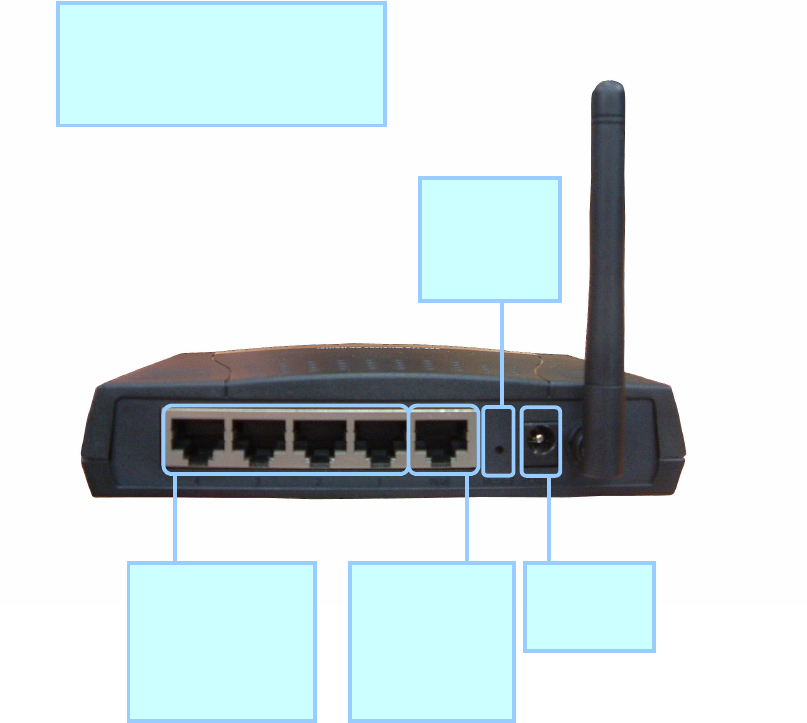
2. Setting up the Hardware
◆ Back View:
Receptor for
the Power
Adapter
Pressing the
Reset Button
restores the
router to its
original factory
default
The Auto
MDI/MDIX WAN
port is the
connection for the
Ethernet cable to
the Cable or DSL
modem
Auto MDI/MDIX LAN
ports automatically
sense the cable type
when connecting to
Ethernet-enabled
computers.
All Ethernet Ports (WAN and LAN)are auto
MDI/MDIX, meaning you can use either a
straight-through or a crossover Ethernet
cable.

◆ LED Indicators:
LED Color Status Description
On Indicates proper connection to power supply.
Power Green OFF The unit is not receiving power
On Indicates connection to the WAN port
WAN Blinking Data transmission.
On Link is established
On Blinking Packet transmit or receive activity
WLAN
Off — No Link activity
On Indicates connection is established.
On Blinking Data transmissions
LAN
Off — No LAN connections
IEEE 802.11g WLAN Router is a turnkey solution to connect your home or office to the
Internet through a high speed or ”always on “ connection. The following easy steps will
get you hooked up and ready to go onto the Internet.
1. Connect the power adapter to the 802.11g WLAN Router and the outlet, the power will
be on automatically.
2. Behind the IEEE 802.11g WLAN Router unit, locate the Ethernet network port (RJ-45)
marked with WAN and connect the port to the equipment provided by your Internet
Service Provider (ISP) (e.g. Cable/DSL modem or T1/E1/ISDN CSU/DSU connection).
3. Connect the four local area network (LAN) ports to your office network hub or switch
if necessary.
Congratulations! You have completed the hardware configuration requirements for IEEE
802.11g WLAN Router.
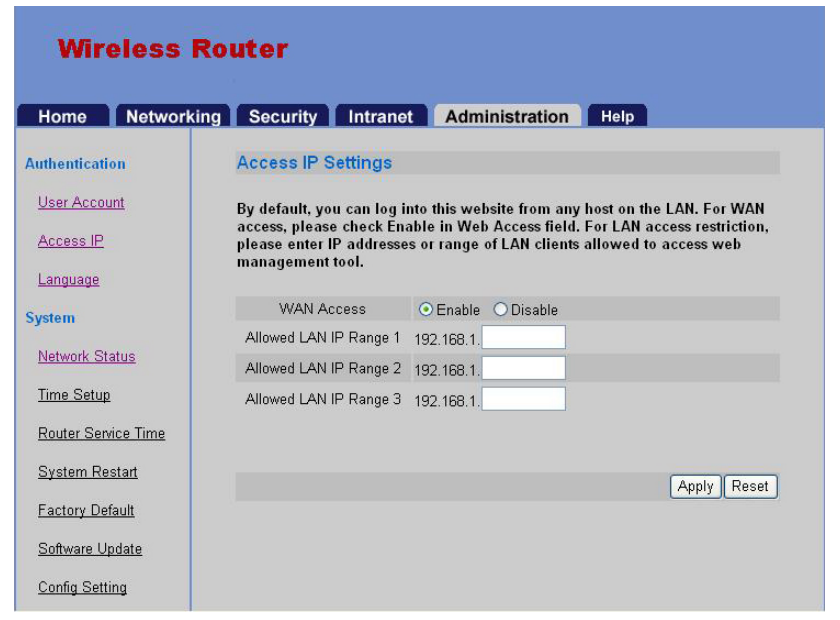
3. Quick Start Guide
A brief overview of setting up your IEEE 802.11g WLAN Router
Welcome to IEEE 802.11g WLAN Router!
Your IEEE 802.11g WLAN Router is a versatile network component that satisfies the
needs of novice and most sophisticated network administrators.
This quick start guide will get you connected to Internet in a number of easy steps.
Before you start, please gather the Internet connection information from your ISP. You
will need to install and configure an Ethernet card properly to obtain a dynamic IP
address on a computer. Depending on your network configuration, you might need an
Ethernet hub / switch and enough Ethernet cables to connect every computer to the
Ethernet hub / switch.
To start using IEEE 802.11g WLAN Router :
1. Follow the steps in setting up the hardware in previous chapter and point your browser
to http://192.168.1.254 to get the graphical user interface (GUI) screen.
2 Enter username/password which set to admin/admin as default value.
3. Click on the WAN tab and enter the Wide Area information provided by your ISP,
click the Update button.
4. Click on the DNS tab and enter the Domain Name Service information provided by
your ISP, click the Update button to confirm.
5. Click on Save Changed and Restart the system.
6. Enjoy the Internet
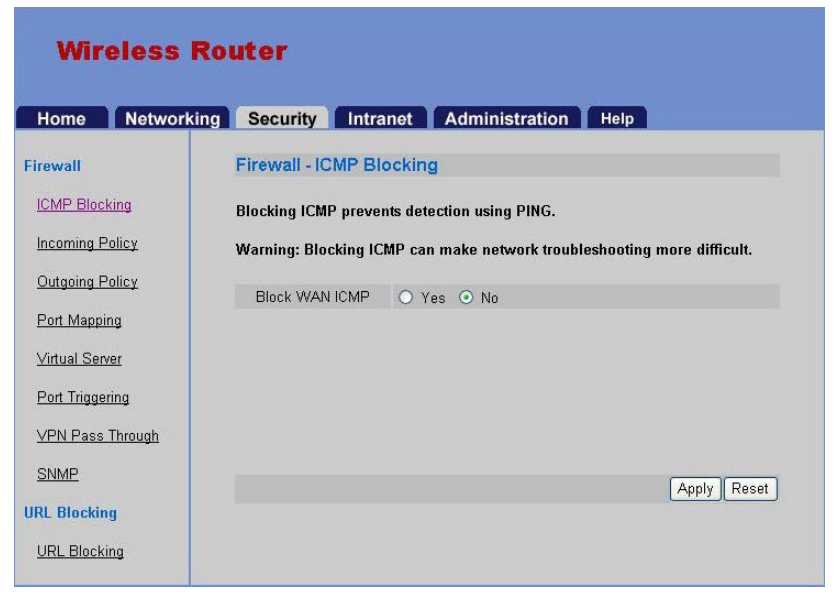
4. Understanding the User Interface
Navigation rules
IEEE 802.11g WLAN Router has a web-based graphical user interface (GUI) that can be
accessed using a standard HTML (HTTP v1.0) compliant browser. Once the LAN is
properly connected, a network administrator can connect to it through the URL
http://192.168.1.254
The GUI has two main navigational components: Tabs and Menus. Each Tab represents a
major group of functions that a user can configure and is located on the top part of the
screen.
The Home tab presents version information as well as a brief feature list. The Networking
tab includes all the essential configuration items required to get a LAN up and running.
The Security tab provides configuration items that control firewall behavior. By default,
IEEE 802.11g WLAN Router comes configured to lock out unsolicited network
connections. To allow specific services to be allowed through IEEE 802.11g WLAN
Router, some modifications under this tab is required.
The Intranet tab accommodates changes that are LAN specific. Under this tab, a network
administrator can specify rules for the assignment of IP addresses as well as manipulate
tools that improve local area network performance and resource availability, such as the
transparent proxy cache.
The Administration Tab provides control, monitoring and troubleshooting tools. The
Help Tab provides additional context sensitive information. Menus are located at the left
side of the screen to provide additional navigation for tab components. After each session
involving configuration modifications, the changes should be saved and the system
should be restarted to activate the changes.
5. Basic Configuration
First things first
This chapter covers the use of all the configuration items under the Networking Tab.
Once configured, you should be able to securely access the Internet through your IEEE
802.11g WLAN Router.
Wide Area Network (WAN)
The Internet is made up of wide area networks (WAN) and local area networks (LAN).
Each local area network connects to the Internet through a wide area network. The IEEE
802.11g WLAN Router is the gateway used by your LAN to connect to your WAN. Your
WAN is provided by your Internet Service Provider (ISP) using a WAN medium
(Cable/DSL modem or T1/E1/ISDN CSU/DSU connection).
You will need information provided by your ISP to complete this step. Depending on
your WAN medium, your ISP may provide you with either a static or dynamic
(DHCP/BootP) connection. This information should be included in the package that came
from your ISP. Generally, if your ISP has provided you with a fixed IP address, you have
a static IP address. If your ISP has provided a username and password, you have a PPPoE
link. If your ISP provided neither an IP address or username/password pair, you most
likely have a DHCP based connection. If unsure, contact your Internet Service Provider
customer support.
Dynamic Host Configuration Protocol (DHCP) based configurations do not require
further setup since IP address, gateway and DNS information are automatically set by the
ISP.
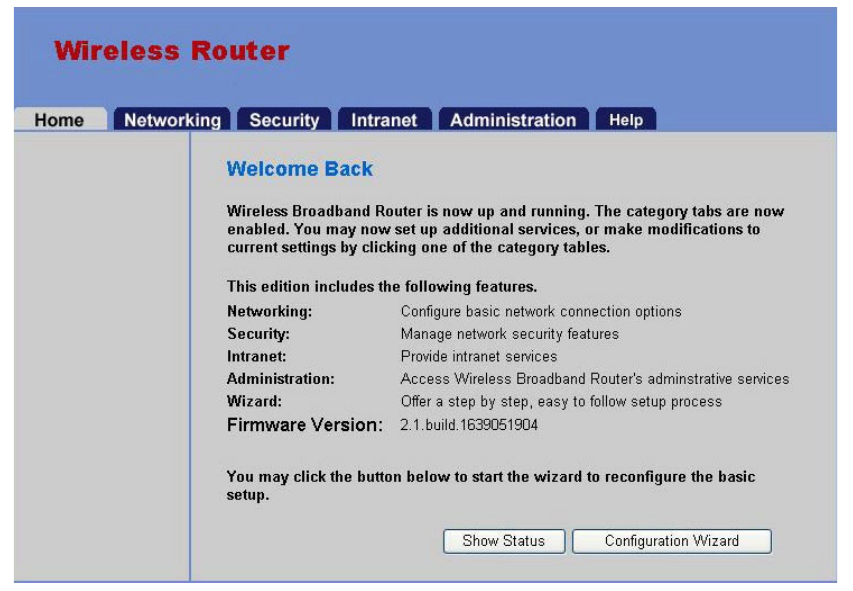
5.1. WIZARD
When you first connected to IEEE 802.11g WLAN Router, you will need to complete the
setup by answering a sequence of questions provided by the Configuration Wizard.
5.1.1. Setting up the Configuration Wizard
1. Follow the instructions guided by the Configuration Wizard step by step through the
graphical user interface on the browser..
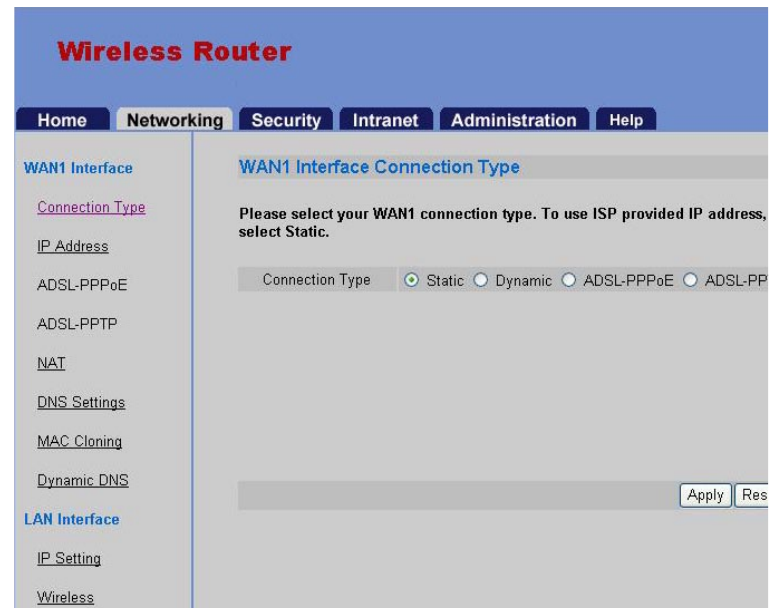
5.2. NETWORKING
The Networking section will guide you to complete your Internet setup.
5.2.1. Connection Type Setup
1. Select Connection type item under WAN interface in the Networking section.
2. Click Static.
3. Click Apply.
4. Input settings which the network connection required
5. Wait about 30 seconds for System Restart
6. Verify if LAN clients can access Internet and if there is any error messages shown on
the web page.
7. Repeat step 1.
8. Click Dynamic item.
9. Repeat step 3-6.
10. Repeat step 1.
11. Click ADSL-PPPoE item.
12. Repeat procedure 3-6.
13. Repeat step 1.
14. Click ADSL-PPTP item.
15. Repeat procedure 3-6
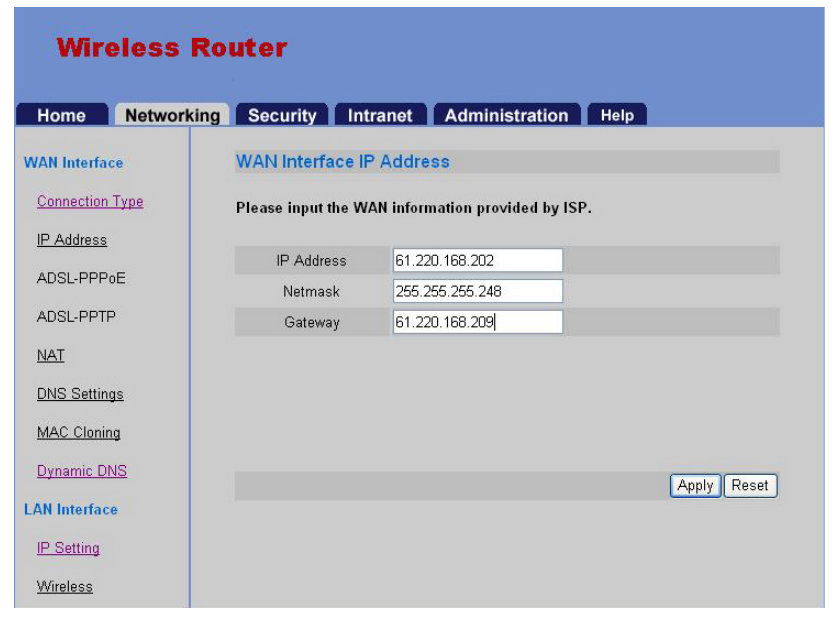
5.2.2. Configuring a Static IP Address
1. Click on Connection Type under WAN1 Interface in the Networking tab.
2. Click on Static and press Apply.
3. Enter IP Address (ex: 61.220.168.202), Netmask (ex: 255.255.255.248), Gateway (ex:
61.220.168.209) and press Apply.
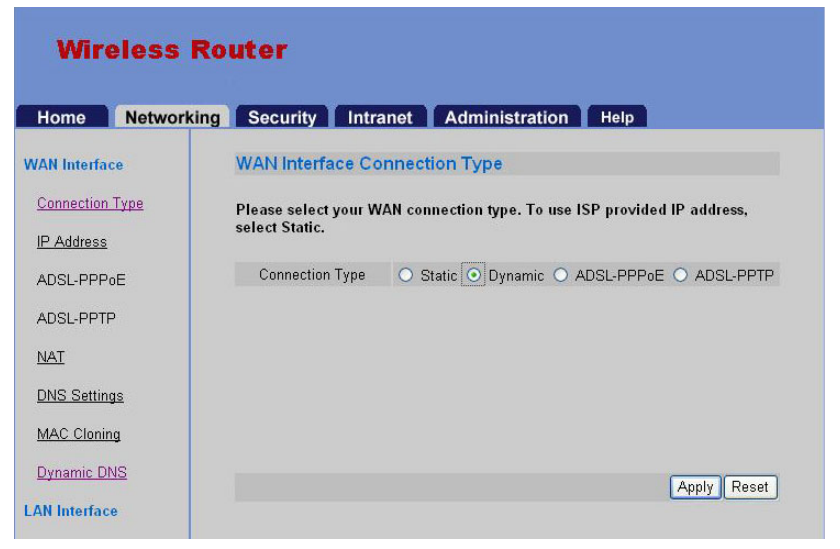
5.2.3. Configuring a (Dynamic) DHCP Account
DHCP accounts do not need further configuration. However, for DHCP accounts with
ISPs that restrict IP addresses to specific MAC addresses, see the subsection on MAC
Cloning in the Advanced Networking Tools section of this chapter.
1. Click on Connection Type under WAN1 Interface in the Networking tab.
2. Click on Dynamic and press Apply.
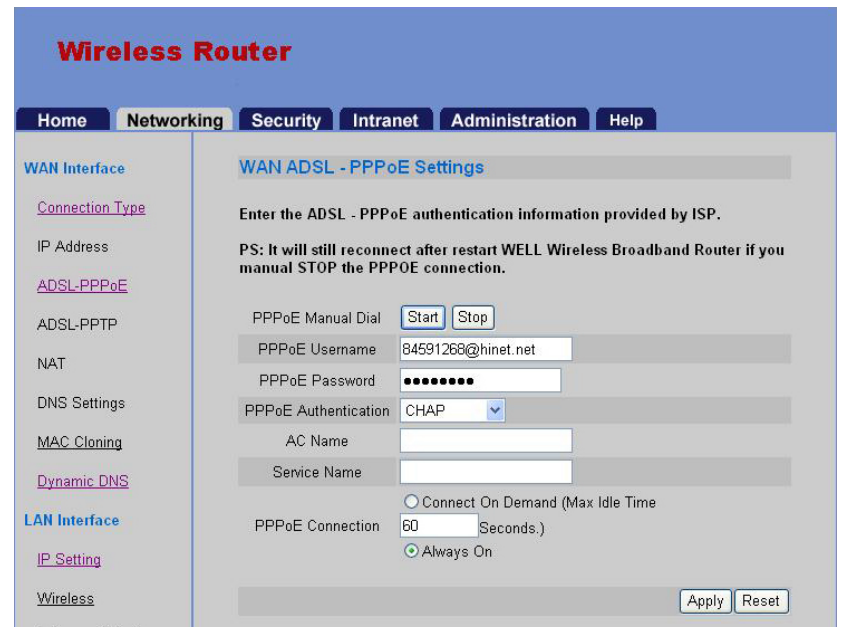
5.2.4. Configuring IEEE 802.11g WLAN Router to Use a ADSL PPPoE
Account
ADSL-PPPoE (always on)
1. Click on Connection Type under WAN1 Interface in the Networking tab.
2. Click on ADSL-PPPoE and press Apply.
3. Enter PPPoE Username (ex: 84591268@hinet.net), Password (ex: sa123455).
<You will need information provided by your ISP to complete this step>
4. Click on Always On and press Apply.
ADSL-PPPoE Connect On Demand (CoD)
1. Click on Connection Type under WAN1 Interface in the Networking tab.
2. Click on ADSL-PPPoE and press Apply.
3. Enter PPPoE Username (ex: 84591268), PPPoE Password (ex: 123455).
4. Click on Connect On Demand and enter MAX Idle Time.
5. Press Apply.
Starting WAN1 ADSL-PPPoE MANUALLY
1. Click on ADSL-PPPoE under WAN1 Interface in the Networking tab.
2. Click on Start.
Stopping WAN1 ADSL-PPPoE MANUALLY
1. Click on ADSL-PPPoE under WAN1 Interface in the Networking tab.
2. Click on Stop.
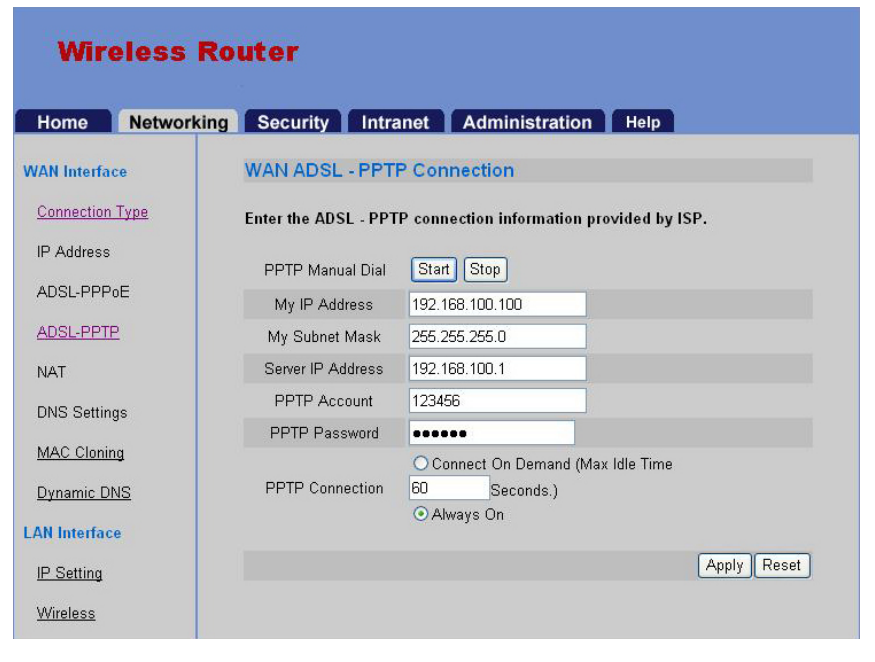
5.2.5. Configuring IEEE 802.11g WLAN Router to Use a PPTP
Connection
1. Click on Connection Type under WAN1 Interface in the Networking tab.
2. Click on ADSL-PPTP and press Apply.
3. Enter My IP Address (192.168.100.100), My Subnet Mask (ex: 255.255.255.0), Server
IP Address (ex: 192.168.100.1), PPTP Account (ex: 123456) , PPTP Password (ex:
123456) and press Apply.
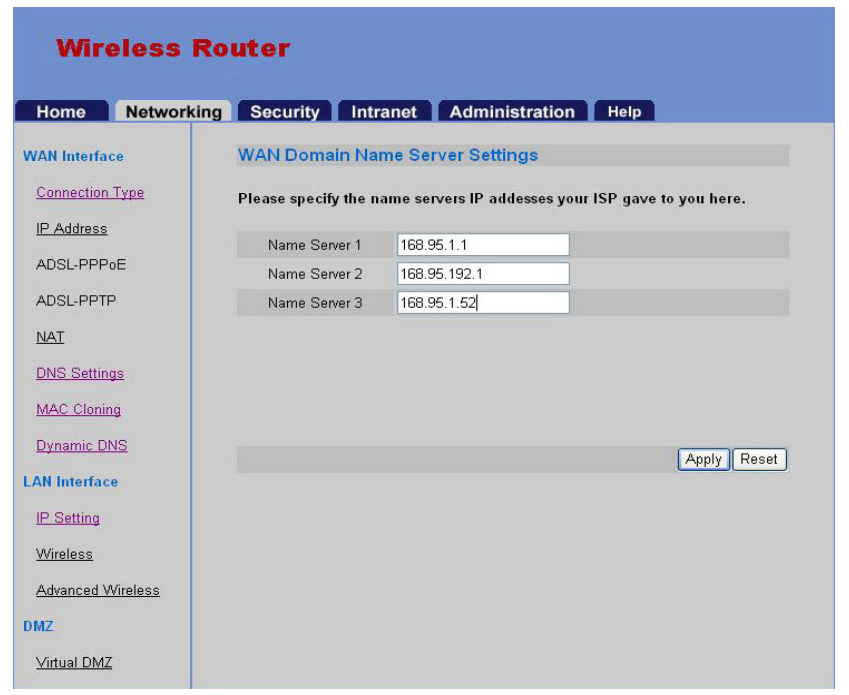
5.2.6. Configuring the DNS Service
Domain Name Service (DNS)
Domain name service helps you to work with IP addresses by mapping them out to
simple “human readable “ names. IEEE 802.11g WLAN Router needs the correct values
for certain LAN side client services (like web-browsing) to work properly. The DNS
server IP addresses should be provided to you by your ISP.
1. Click on DNS Settings under WAN1 Interface in the Networking tab.
2. Enter DNS IP address your ISP gave to you.
3. Press Apply button.
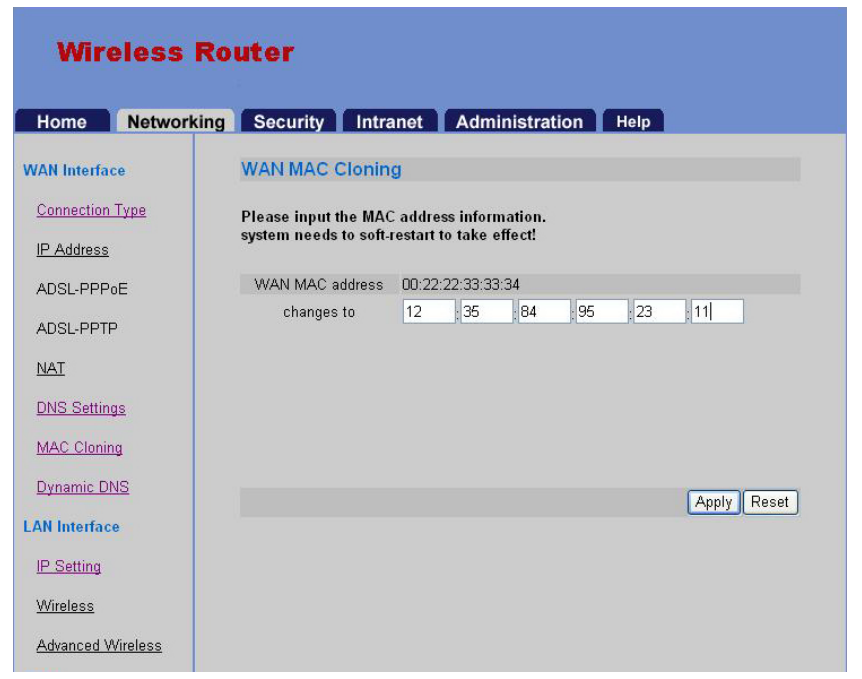
5.2.7. Cloning a MAC Address
Some ISPs audit connections using the MAC addresses. These systems only allow
“registered” MAC address to connect to the Internet. To circumvent this obstacle, IEEE
802.11g WLAN Router provides a“ MAC Cloning” feature which allows the Network
Administrator to modify the MAC address that is reported to the ISP. This feature
facilitates the use of IEEE 802.11g WLAN Router in such environments.
1. Click on MAC Cloning under WAN1 Interface in the Networking tab.
2. Enter MAC Address (ex: 12:35:84:95:23:11) and press Apply.

5.2.8. Dynamic DNS Configuration
Conventional DNS information associates a static IP address with a human readable
machine name, for use on the World Wide Web. When a DNS server receives a name
lookup request, it compares it against a list of published IP-host name associations. Once
a match is found, the server replies with either the IP address or host name. Since the
published lists are static, conventional DNS servers are unable to map DHCP or PPPoE
configured hosts as the configuration protocols do not guarantee that the host computer
will always have the same IP address. (thus, the IP address-hostname mapping will not
always be correct).
Dynamic DNS overcomes the fixed IP requirement of conventional DNS by running a
daemon that automatically updates DNS server information. To avail of this service, you
will have to register with one of several dynamic DNS service providers and configure
IEEE 802.11g WLAN Router to forward IP address changes to the dynamic DNS server.
This feature is particularly useful for providing WAN side services (e.g. HTTP or FTP).
1. Click on Dynamic DNS under WAN1 Interface in the Networking tab.
2. Click on Enable.
3. Choose Service Provider form combo box (ex: www.dyndns.org).
4. Enter Host Name (ex: 1234), Username (ex: 123564), Password (ex: 123564).
5. If necessary, click on Enable Wildcard and enter Mail Exchanger (ex:
mail.123564.com).
6. Press Apply.
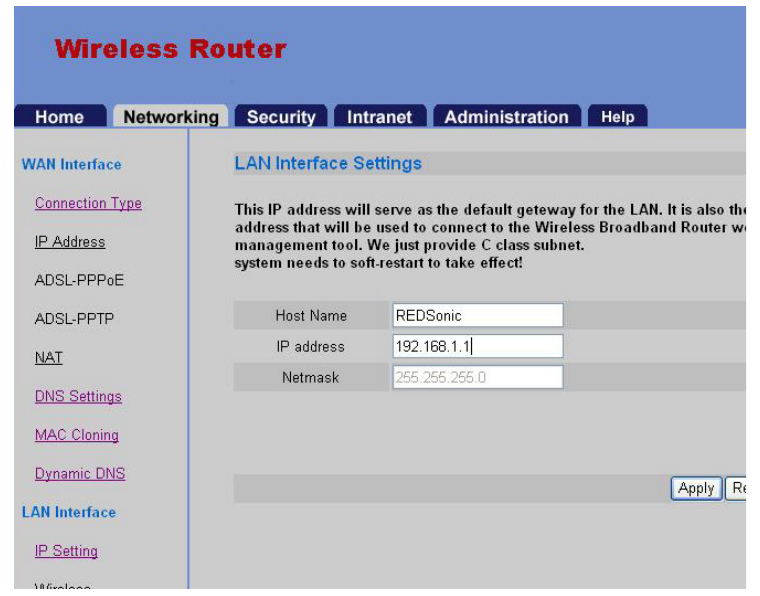
5.2.9. LAN Interface Configuration
In this section, you specify the IP address that the IEEE 802.11g WLAN Router will use.
IEEE 802.11g WLAN Router uses 192.168.1.1 as its default address, with a netmask of
255.255.255.0 (Class C netmask) . This IP is used as the default router for the LAN as
well as the Web server address for the IEEE 802.11g WLAN Router configuration
interface.
IEEE 802.11g WLAN Router allows a single Internet account to be shared by several
computers. This is done through a principle called Network Address Translation (or
NAT). Connection requests from LAN side computers are translated into the single IP
address provided through the ISP account.
IEEE 802.11g WLAN Router tracks each individual LAN client connection in a way that
the process is transparent to the LAN side computers. The NAT mechanism also provides
part of the firewall features of IEEE 802.11g WLAN Router since only LAN side
initiated connections are translated. WAN side connection attempts are ignored unless
specifically configured to be accepted (see chapter on Security).
1. Click on IP Setting under LAN Interface in the Networking tab.
2. Enter Host Name, IP address and press Apply.
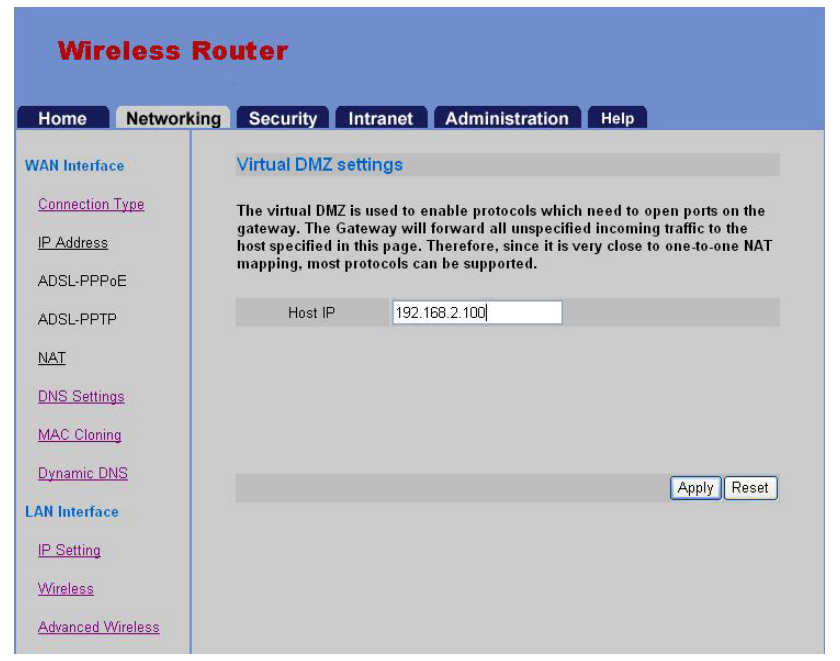
5.2.10. Virtual DMZ Configuration
The virtual DMZ is used to enable protocols which need to open ports on the gateway.
The Gateway will forward all unspecified incoming traffic to the host specified in this
page. Therefore, since it is very close to one-to-one NAT mapping, most protocols can be
supported. In general, Internet applications use only one unique port and can pass through
a NAT Router by enabling Virtual Server. However, some special applications need to
implement multiple ports, port ranges, dynamically assigned ports, and special protocols.
IEEE 802.11g WLAN Router can support the transparent pass-through of these special
applications, such as NetMeeting/H.323, and ICQ etc. Enable Virtual DMZ when you
have problems running these applications.
1. Click on Virtual DMZ under DMZ in the Networking tab.
2. Enter Host IP address and press Apply.
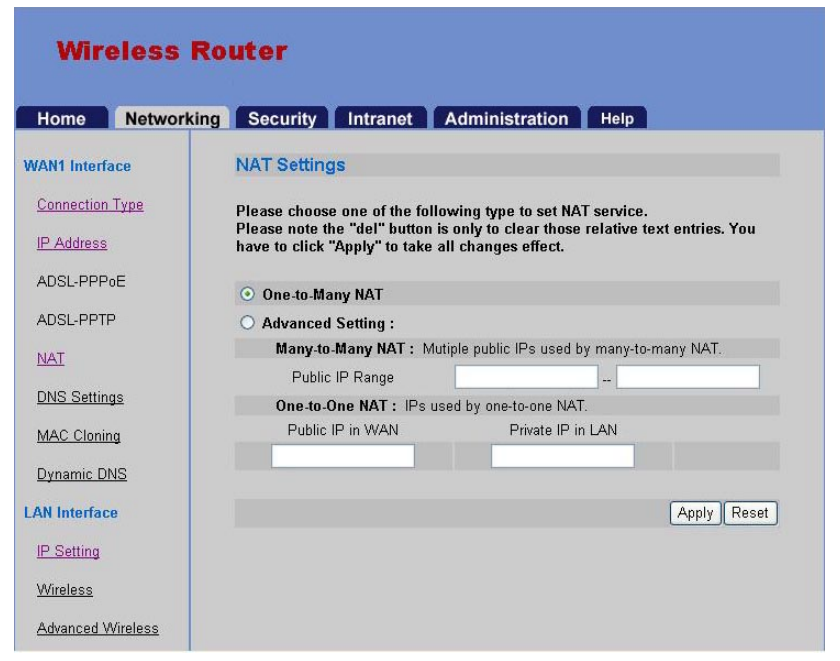
5.2.11. NAT Configuration (Static Connection)
SET UP ONE-TO-MANY NAT WITH WAN1 INTERFACE
1. Click on NAT under WAN1 Interface in the Networking tab.
2. Click on One-to-Many NAT and press Apply.
SET UP MANY-TO-MANY NAT WITH WAN1 INTERFACE
1. Click on NAT under WAN1 Interface in the Networking tab.
2. Click on Advanced Setting.
3. Enter Public IP Range (ex: 61.220.168.202-61.220.168.206).
4. Press Apply.
SET UP ONE-TO-ONE NAT WITH WAN1 INTERFACE
1. Click on NAT under WAN Interface in the Networking tab.
2. Click on Advanced Setting.
3. Enter Public IP in WAN (ex: 61.220.168.204), Private IP in LAN (ex: 192.168.1.50).
4. Press Apply.
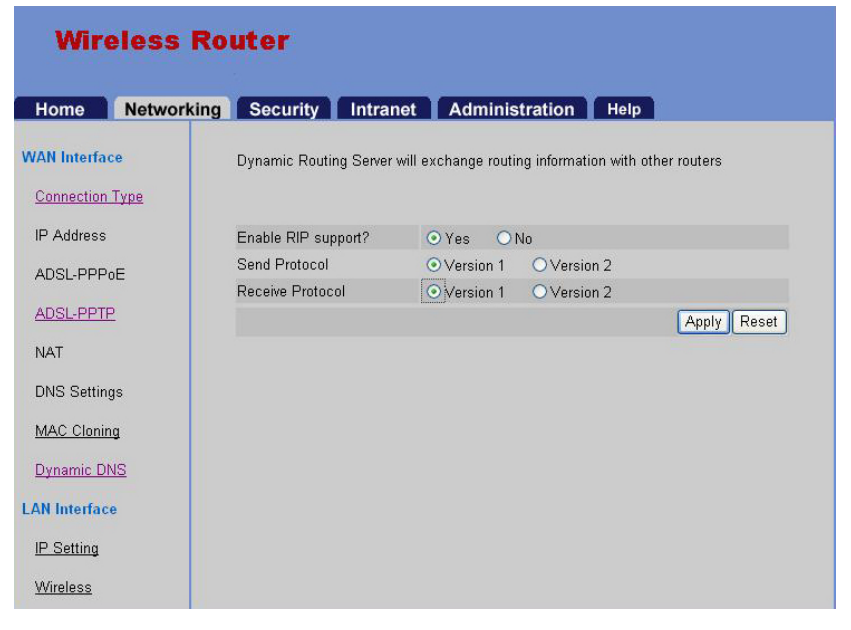
5.2.12. Router Service Configuration
DYNAMIC ROUTING
1. On Dynamic Routing under Router Services in the Networking tab.
2. Click on Yes to enable RIP support.
3. Choose on Version 1 of Send and Receive Protocol.
4. Press Apply.
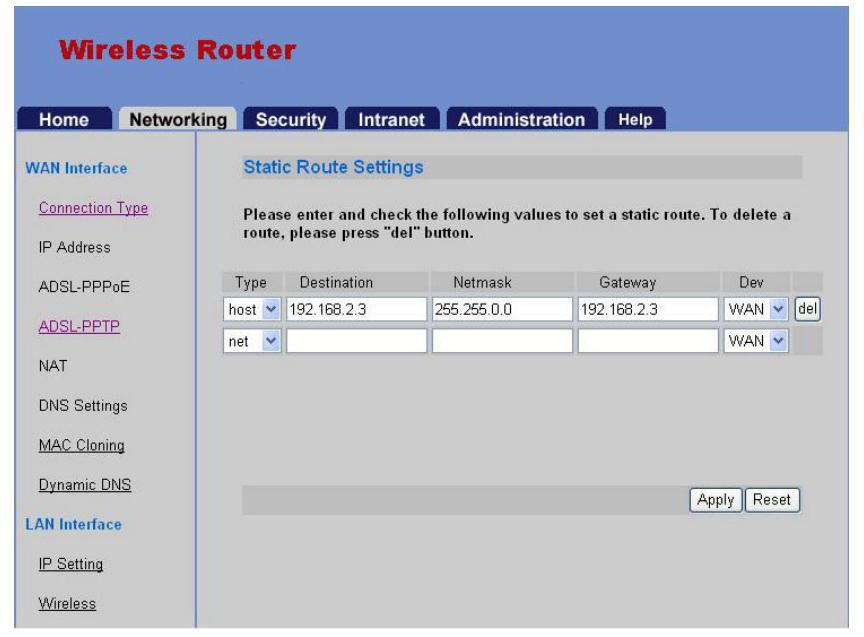
STATIC ROUTE
1. Click on Static Route under Router Services in the Networking tab.
2. Choose net from Type combo box.
3. Enter Destination, Netmask and Gateway.
4. Choose WAN1 from Dev combo box.
5. Press Apply.
SETTING STATIC ROUTE (NET-TO-HOST)
1. Click on Static Route under Router Services in the Networking tab.
2. Choose host from Type combo box.
3. Enter Destination.
4. Choose WAN1 from Dev combo box.
5. Press Apply.
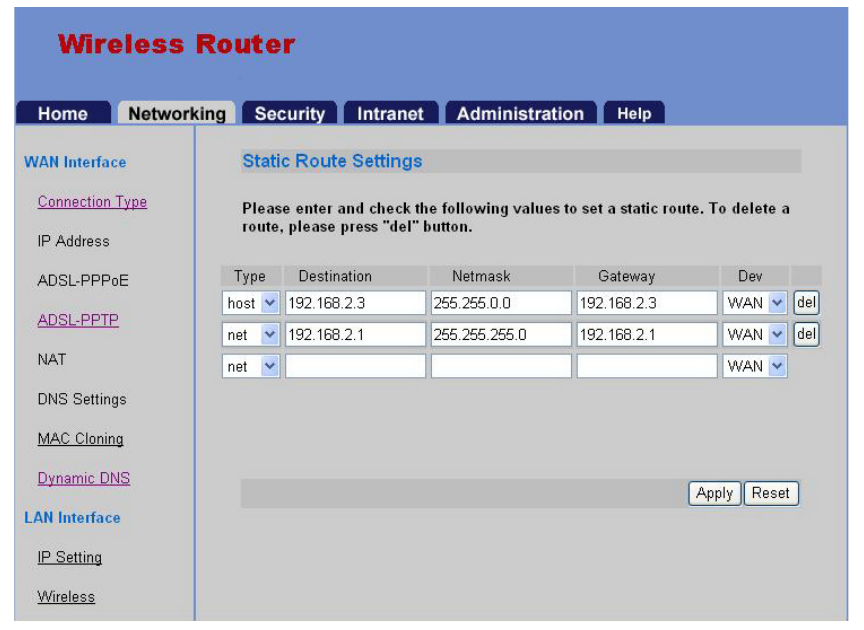
SETTING STATIC ROUTE (NET-TO-NET)
1. Click on Static Route under Router Services in the Networking tab.
2. Choose net from Type combo box.
3. Enter Destination, Netmask and Gateway.
4. Choose WAN1 from Dev combo box.
5. Press Apply.
5.3. SECURITY
IEEE 802.11g WLAN Router is the key to controlling the flow of information
A real world firewall is built between buildings to slow down the progress of a disaster,
and preserve valuable life and property. Network firewalls are put between networks to
control the amount of information that flows through them. One of the fundamental goals
of a firewall is to prevent unwanted connections from the outside of the network from
entering the LAN. On the other hand, a firewall can also block connection from LAN to
the Internet. A common practice of this feature is the URL (Uniform Resource Locator)
blocking used by parents to limit access to certain Internet sites for their children. The
Security tab enables the network administrator to fine-tune or customize various features
of the IEEE 802.11g WLAN Router firewall. Packet Internet Groper (PING) Packet
Internet Groper (or”Ping” is a very useful utility used by network administrators to
determine if a computer is up and running. The ping program sends a small packet to an
address, if there is a computer assigned to the address, it sends a reply. Ping uses the
Internet Control Messaging Protocol (ICMP). IEEE 802.11g WLAN Router can be
configured not to reply to PING requests.
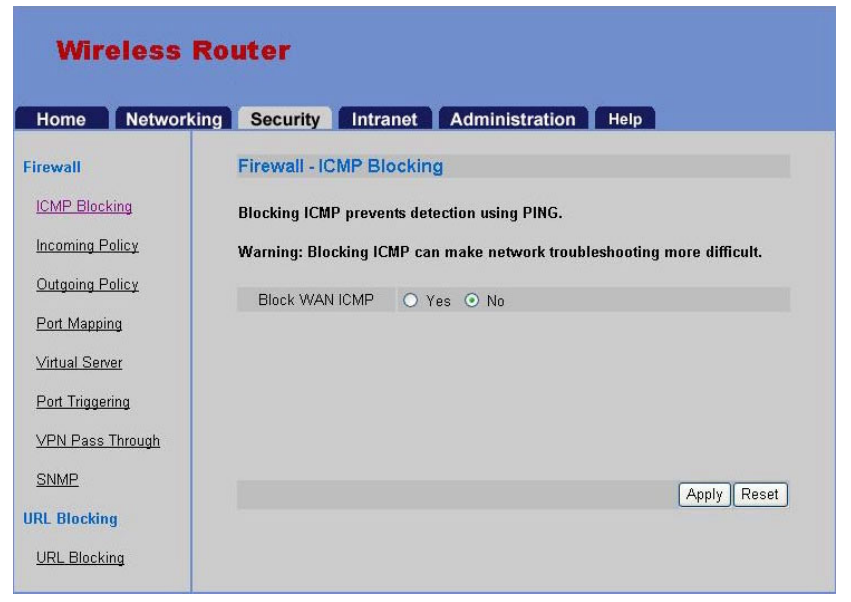
5.3.1. Disabling ICMP Replies
1. Click on ICMP Blocking under Firewall in the Networking tab.
2. Click on No and press Apply.
Keeping Stuff out
IEEE 802.11g WLAN Router blocks all traffic from WAN side computers from getting
into your LAN by default.
On the other hand, LAN clients can connect to any computer that is on the Internet. This
behavior can be modified to prevent particular (or all) LAN clients from accessing certain
WAN side IP addresses. These features are useful for network administrators of offices or
households that have policies or guidelines about the proper use of the Internet.
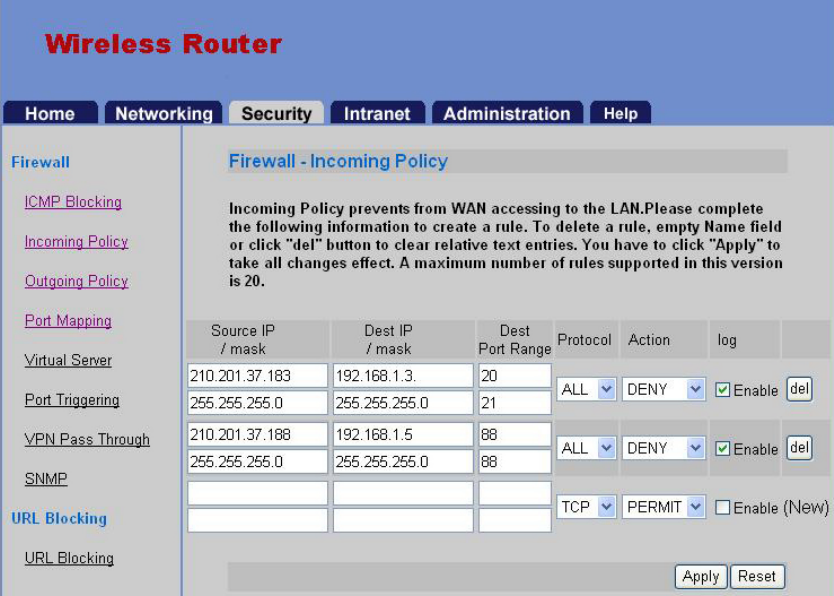
5.3.2. Blocking Individual (or Service Port) of IP Address on the
Internet
1. Click on the Security tab.
2. Under the Firewall menu item, click on Incoming Policy.
3. Enter the IP address and port number (or range) to be blocked onto the corresponding
text box at the bottom of the list (marked New) according the following figure.
4. Click combo box and select PERMIT / DENY action.
5. Check Enable box to log the event
6. Press Apply.
This figure describes all the IP address coming from WAN port will be allowed to access
your LAN clients, but: Accessing to the port 20, 21 of IP 192.168.1.3 from IP
210.201.37.183 (with port 20, 21) will be denied.
Accessing to the port 88 of IP 192.168.1.5 from IP 210.201.37.188 (with port 80) will be
denied.
5.3.3. Modifying an IP Address or Removing an Policy from the
Incoming Policy List
1. Click on the Security tab
2. Under the Firewall menu item, click on Incoming Policy.
3. To modify an IP address, enter new parameters.
4. To remove a Policy, click the del key
5. Press Apply.